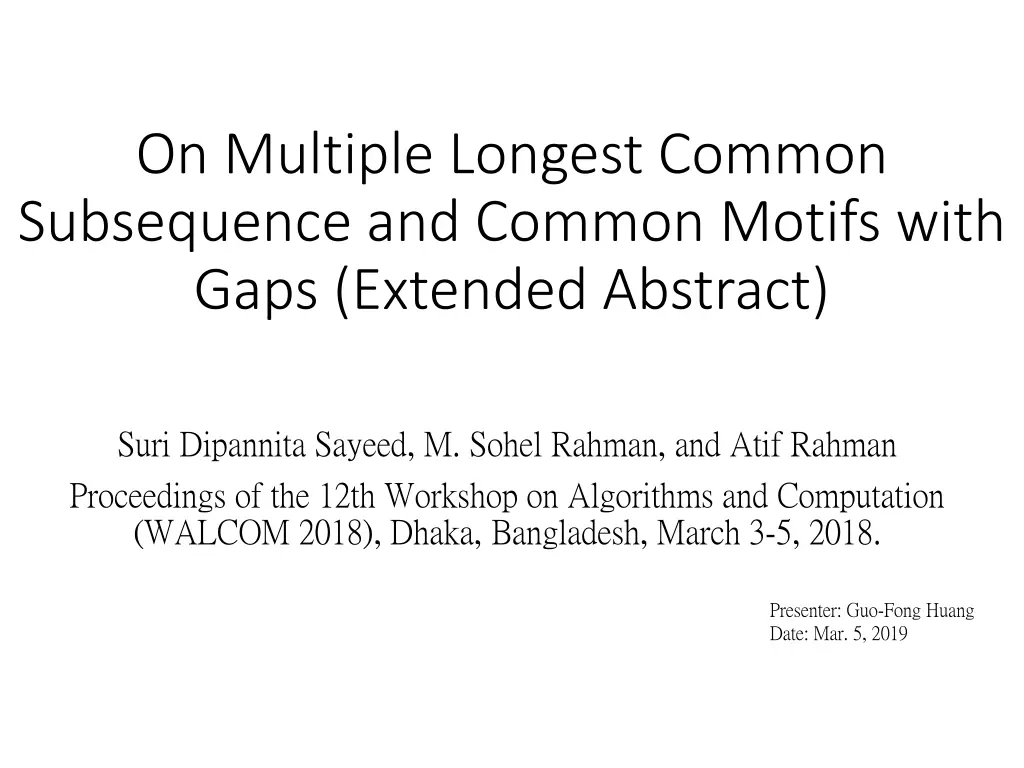
Multiple Longest Common Subsequence and Common Motifs with Gaps Study
Dive into the complex world of motif finding and common motifs with gaps in sequences. Discover how NP-hard problems are tackled through algorithms, and explore the intricacies of common patterns in a set of strings. Unravel the challenges and solutions in identifying recurring motifs with gaps, and explore the branch-and-bound algorithm for Multiple Longest Common Subsequence (MLCS) problems.
Download Presentation

Please find below an Image/Link to download the presentation.
The content on the website is provided AS IS for your information and personal use only. It may not be sold, licensed, or shared on other websites without obtaining consent from the author. If you encounter any issues during the download, it is possible that the publisher has removed the file from their server.
You are allowed to download the files provided on this website for personal or commercial use, subject to the condition that they are used lawfully. All files are the property of their respective owners.
The content on the website is provided AS IS for your information and personal use only. It may not be sold, licensed, or shared on other websites without obtaining consent from the author.
E N D
Presentation Transcript
On Multiple Longest Common Subsequence and Common Motifs with Gaps (Extended Abstract) Suri Dipannita Sayeed, M. Sohel Rahman, and Atif Rahman Proceedings of the 12th Workshop on Algorithms and Computation (WALCOM 2018), Dhaka, Bangladesh, March 3-5, 2018. Presenter: Guo-Fong Huang Date: Mar. 5, 2019
Abstract Motif finding is the problem of identifying recurring patterns in sequences. It has been widely studied and several variants have been proposed. Here, we address the problem of finding common motifs with gaps that are present in all strings of a finite set. We prove that the problem is NP-hard by reducing the multiple longest common subsequence (MLCS) problem to it. We also provide a branch and bound algorithm for MLCS and show how the algorithm can be extended to give an algorithm for finding common motifs with gaps after common factors that occur in all the strings have been identified.
Preliminaries: Common Motifs with Gaps A set of strings S = {S1, S2, .., Sd} Alphabet = {A, C, G, T} Two integers p,q, where 1 p q min(|Sj | : j {1,...,d}) For example: common motifs, p=1, q=2 S1= ACAAAACACAAA S2= ACACCAACCACA S3= CACAAACCACCA optimization version: maximum common words decision version: give m, find whether there is a common motif with gaps with m factors.
Preliminaries: Multiple Longest Common Subsequence A set of strings S = {S1, S2, .., Sd} S1= informatics S2= bioinformatics S3= proteomics optimization version: find longest common subsequecne in S decision version: give m, find whether there is a m length solution of MLCS in S.
Complexity of Common Motifs with Gaps Complexity of Common Motifs with Gaps MLCS P CMG AAC G ACA G ACC G CAA ACA T AAC T ACC T CAA AAC T ACC T ACA T CAA 001 010 011 100 010 001 011 100 001 011 010 100 abcd bacd acbd 1234 2134 1324 p = log | |
A Branch and Bound Algorithm for MLCS Problem X=AGCGTGC Y=CTACGCG Z=GCACGCT longest common suffix: ? ?,? > 0 ??? ??? ? ? + 1,?,?,? ? ? + 1
A Branch and Bound Algorithm for CMG Problem X=AGCGTGC Y=CTACGCG Z=GCACGCT longest common suffix: ? ?,? > 0 ??? ??? ? ? + 1,?,?,? ? ? + 1
